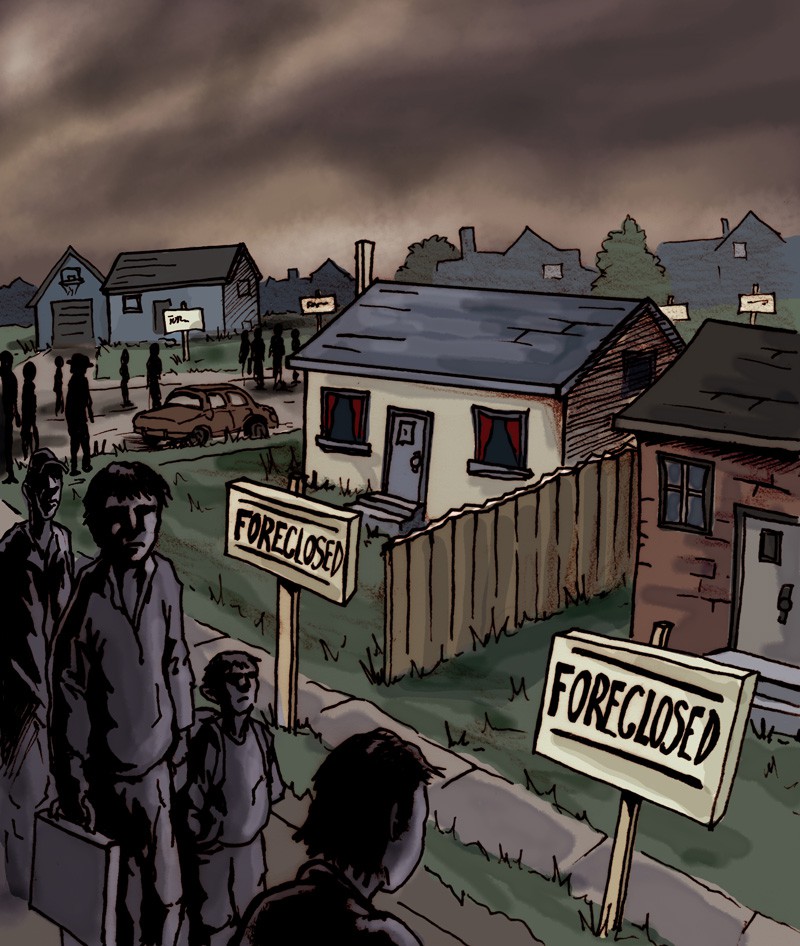
Ah, springtime, 1930. U.S. stock markets had slightly recovered from the “Black Tuesday” crash of the year before. Credit was cheap and the Western world was spending freely. Though people had been spooked, optimism reigned again. Few people knew that the entire global economy was on the edge of a precipice and about to begin a slow, brutal, downward spiral that would usher in almost a decade of misery for countless Canadians and others around the world.
If you’ve been following the recent financial news about the “subprime crisis” closely, some of this might sound eerily familiar. This financial fiasco involving thousands of mortgage defaults in the U.S. was considered by many to be a minor bump in the road when it made headlines last August. And now? The U.S. is in recession and there is speculation it will spread to other countries.
Few understand what caused the subprime crisis. But dig a little and you’ll find a volatile economic state of affairs that could trigger the most significant economic meltdown in 80 years. Countless homeowners across the U.S. will be devastated. And contrary to what you may be hearing, the crisis is worsening and will spread to Canada.
Enough rope to hang themselves
“Giving bad loans to people who could not pay them” was the cause of this crisis, says Louis-Philippe Rochon, associate professor of economics at Laurentian University. The bad loans he refers to are “subprime” mortgages: high-risk, high-interest loans made to people who would normally not qualify for mortgages, usually due to bad credit history. These loans were unheard of before 2001, but by 2006 they had become the primary engine driving growth in the U.S. housing market.
Loaning money to people with bad credit is risky for the lender, since there’s a greater chance the borrower will default. For that reason, the loans often carry higher interest rates and surcharges that kick in after an initial grace period. By charging a high enough interest rate, lenders calculated that they would recover enough from the borrowers who didn’t default to make the entire gambit profitable. At least, that was the theory.
In retrospect, many of the loans given were inviting disaster. Borrowers who could barely afford even the low introductory rate were approved en masse; mortgages given were sometimes worth more than the value of the properties bought; some came with “pay-only-interest” periods or even periods during which the total amount owed would continue to grow. And the introductory rates were almost guaranteed to go much higher, causing nearly 1.3 million people to fall into foreclosure proceedings in 2007.
For these U.S. homeowners, the debt load was manageable on one condition: that the value of their homes kept going up. But starting in 2005, the housing boom began to go bust. As Diane Francis, writing for the National Post, put it, subprime mortgages had created a new underclass of “homeowners with mortgages they never should have obtained who cannot make the payments because interest rates have gone up and who cannot sell because house values have gone down.”
The subprime market was massive: almost 40 per cent of all U.S. mortgages were classified as high-risk by 2006, and evidence of predatory lending was growing. According to the Wall Street Journal, 61 per cent of subprime loan recipients that year had credit scores high enough that they would have qualified for easier-to-manage conventional mortgages. Specific regions like San Diego and Cleveland were hardest hit, with 80 per cent of new mortgages considered high-risk as early as 2004.
The fallout has been equally massive. By October 2007, mortgage foreclosure rates had doubled over the previous October. Twenty subprime lenders went bankrupt, including the U.S.‘s largest, New Century Financial. Four hundred billion dollars in adjustable rate mortgages reset to higher interest rates in 2007, with the introductory rates on a further $500 billion in mortgages set to reset in 2008. The industry is bracing itself for fresh waves of bankruptcies in the wake of these resets.
$338: The amount, on average, that every homeowner in the U.S. lost each week over the past year on the value of their home ($17,576 over the year).
$2,788: The amount, on average, that every homeowner in California lost each week over the past year on the value of their home ($144,976 over the year). (Source: Los Angeles Times, March 26, 2008)
Foreclosure and financial ruin
In August 2007, banks and lenders around the world who held the subprime mortgages as “assets” announced massive losses, sending markets into chaos. In September 2007 the BBC reported that British and European banks could be on the hook for as much as $142 billion. A month later, the Wall Street Journal said $20 billion had been lost by major financial corporations like Merill Lynch. As of March 2008, worldwide losses stood at over $175 billion.
The problems have spread beyond finance, says Julian Delasantellis, a Washington-based management consultant and writer for the Asia Times. “Home building has been leveled,” he said in August 2007, citing the falling profits of Home Depot, Wal-Mart and Hovnanian. “The carry trade market,” a large currency market, “is gone.” Meanwhile, though they only have minor connections to lending or mortgages, mining and metals (aside from gold) have been some of the most negatively affected industries.
Worst of all, many homeowners are facing foreclosure and financial ruin. According to the National Community Reinvestment Coalition and research firm RealtyTrac, as many as 2.2 million Americans could lose their homes in the next few years. Sections of some U.S. cities like Sacramento and Detroit already look like ghost towns. House prices are now falling so fast that even people with prime mortgages are defaulting and losing their homes, either unable to make their payments or choosing to walk away from loans that now exceed the value of their homes. Fully 10 per cent of U.S. homeowners-8.8 million people-now owe more on their mortgages than their homes are worth.
A factor not often mentioned in media accounts of the crisis is the background of many of these soon-to-be-former-homeowners. Seniors and people of colour account for a disproportionate amount of subprime loans in the U.S., so much so that the City of Baltimore is suing Wells Fargo, claiming that they charged higher fees for black borrowers and intentionally targeted black neighbourhoods over white ones for higher-risk loans.
According to U.S. government figures, people of colour are more than three times more likely to have subprime loans than whites, with these loans accounting for 55 per cent of loans to African Americans compared to only 17 per cent of loans to whites. A January 2008 report by the group United for a Fair Economy estimates that the subprime crisis will cause people of colour in the U.S. to lose up to $213 billion.
By many accounts, it is going to get worse. Housing prices are expected to keep falling-“almost like never before, with the exception of the Great Depression,” according to Countrywide Financial Corporation CEO Angelo R. Mozilo. Similarly, Nouriel Roubini, chairman of Roubini Global Economics, has warned of “a systemic banking crisis like we haven’t had since the 1930s.”
“8.8 million U.S. homeowners-about 10 per cent of the total-now owe more on their mortgages than their homes are worth.”
Even worse than the housing crisis
Though the increase in foreclosures is going to cause problems for years to come, Delasantellis says that the magnitude of the banking crisis caused by the subprime crisis actually exceeds the housing crisis itself.
The reason has to do with the fact that subprime lenders, rather than treating their loans as liabilities (as outstanding debts that carried a risk of never being paid back), treated them as assets-as sure things-to be resold for a profit at inflated prices. Subprime loans were bundled with other debt such as car, credit card and student loans, and then sold to thousands of investors who often knew little or nothing about the level of risk associated with the debt obligations they were buying. The sales of this bundled debt allowed the subprime lenders to make even more risky loans. This led to exponential growth in cheap lending, speculation, and exotic, poorly understood financial products.
When homeowners started defaulting on their mortgages, it triggered a financial avalanche. Banks and lenders, who need to keep a certain amount of cash on hand to be able to make loans, lost money on the bad debts. Then, with recently vacated houses flooding the market, home values began to fall. Investors who had bought debt bundles, credit derivatives and other financial products got nervous and wanted their money back. They stopped buying the debt bundles, and because all different kinds of debt had been bundled together, no one knew what any of it was worth. All of a sudden, the banks had less cash on hand, and were less able to make cheap loans.
Credit became more expensive and those financial markets dependent on cheap credit began to collapse, leading to major losses for hedge funds, pensions and the stock market as a whole.
“A lot of economic growth in the last decade,” Delasantellis points out, “was simply created out of cheap credit.” But now, “people are not willing to leave money in the markets. They are afraid people will default on loans.”
Where it was once easy for companies to find a business loan and for people to get a mortgage, everyone who uses or benefits from cheap credit-which includes most of us, in one way or another-is now faced with a credit crunch. U.S. cities are now finding out what life without cheap credit is like. Interest has been ballooning on debt they currently hold, which has been jeopardizing their ability to maintain services. According to the World Socialist Web Site, the “Port Authority of New York and New Jersey saw the interest rate it pays jump from 4.3 per cent to 20 per cent,” even as the U.S. Federal Reserve has drastically cut its interest rates from over 5.25 per cent to 2.25 per cent over 12 months in a desperate bid to boost lending.
The real problem is that no one knows where or when the cascading crisis is going to end. Fear is rampant in the markets and in industry because, in theory, any sector or any bank in any part of the world could run into problems in the future as a result of a shortage of cheap credit. As credit disappears, the “house of cards” it built may come quickly crashing down.
When the U.S. sneezes …
The problems have by no means been contained to the U.S. Because subprime loans were bundled with other debt and then sold off to other investors, banks and traders around the world have been hit hard.
Big-name German, French and Australian banks have suffered massive losses, as have European and Asian stock markets. “Hard working Asian savers will see their central banks post billions of dollars in losses on the U.S. mortgage crisis in the next few years,” writes Chan Akya in the Asia Times. The British bank Northern Rock suffered a classic bank run which saw almost £2 billion withdrawn by panicked customers over a three-day period. It has recently been nationalized.
But in Canada, the impact has been much different than what other countries have seen. Although many are quick to point out that housing and banking conditions are very different in Canada than in the U.S.-we have a very small credit derivative market, and only five per cent of Canadian mortgages are subprime-others point to major problems in store for the Canadian economy.
Greg Albo, professor of political science at York University, believes that the fall in housing prices will eventually spread to Canada. “There are a number of real-estate linkages between Canada and the U.S. What impacts the U.S. will have effects in the Canadian housing market. We haven’t seen it yet, except in the Windsor area,” he said.
The collapse of the housing sector in the U.S. has meant that the demand for Canadian exports has dropped. As the numbers of new homes sold in the U.S. doubled between 1995 and 2005, the Canadian market increasingly came to rely on its strength as a resource exporter to the U.S. market. Tom Rosser, chief economist for the Forest Products Association of Canada, says that the decline in residential construction has had a “very definite impact on solid wood products,” as 80 per cent of those products normally go to the U.S. He says that a huge supply of unsold U.S. homes, especially with banks now tightening requirements for mortgages, could keep U.S. house prices down for a long time. Recently, the B.C. government’s budget showed that merchandise exports dropped throughout 2007 while forestry exports were down almost 10 per cent.
Though Rosser stated that he is optimistic in the long term, he does note that long-time members of the industry were saying months ago that “this is as tough as we have seen it.” Conditions have deteriorated since then. James Shepard, the CEO of Canfor, a major Canadian forestry company, recently stated that “the market is dropping faster than our ability to bring our costs down. I’ve never seen anything like it. We’re dealing with a tsunami, really.” The downturn in U.S. housing, the pine beetle infestation, labour disputes in B.C., the rise of the Canadian dollar and the credit crunch led to 130 instances of mills closing across Canada in 2007.
“No one knows where or when the cascading crisis is going to end.”
h3.“Bad situation even worse”
Andrew Jackson, economist for the Canadian Labour Congress, says another major problem for Canada is tied up in U.S. household debt. According to the U.S. Federal Reserve, American homeowners took $705 billion in equity out of their homes in 2005, spending almost two thirds on personal consumption, home improvements and credit card debt.
Jackson predicted in October 2007 that the fall in U.S. home values would have a “strong spill-over effect” on the Canadian export industry because “so much of the strength in U.S. buying [of Canadian exports] in recent years has been because people have been able to borrow against [the equity] in their homes.” He noted that for Canadian auto exports, this will “make a bad situation even worse” as “forecasts are saying that there will be a 20 to 30 per cent decrease in equity of U.S. homes.”
Two hundred workers at a truck plant in Oshawa recently felt the subprime fallout when General Motors cancelled a shift, saying that sales of trucks-many destined for construction companies-had plummeted. This could mean tough times indeed for a manufacturing industry still recovering from the loss of 300,000 jobs since 2002, mainly due to the high Canadian dollar.
The Canadian government responded in January with a $1 billion bailout package, but the Canadian Centre for Policy Alternatives has warned that, because of the $60 billion in recent tax cuts, the government has dramatically reduced its ability to raise revenues, meaning that if a recession or economic slowdown spreads to Canada, the much-touted Canadian “budget surplus” could easily become a deficit.
Mixed prognosis for the Canadian economy
So could this be the end of the U.S. financial system? Albo doesn’t think so. “I think this will cause a generalized slowdown, variable by region, but I do not think it will cause a generalized crisis or a break from so-called “˜neoliberalism.’ No political actors are organizing to break neoliberalism, so the logic will be to have working people bear the cost,” he said, predicting that governments and taxpayers around the world will take on the bad debt created and held by banks, as the British and American governments did with Northern Rock and Bear Stearns.
In truth, few politicians have addressed the structural problems caused by the subprime crisis. The U.S. government continues to ignore the systemic problems with their economy, injecting billions of dollars to prop up the banks that created the crisis in the first place. Democratic presidential front-runners are more inclined to talk about NAFTA than banking regulation and debt addiction. Little has been done to protect Americans being thrown out of their homes, and less has been done to prosecute unscrupulous lenders.
Though many will lose their jobs and Canadian manufacturing and exports will have a tough time ahead, industry leaders say both industries have the ability to survive. Rosser says that due to long-term demand and because industries such as B.C. pulp and paper are some of the “most efficient in the world,” Canadian manufacturing has yet to sound the death knell.
There might even be a silver lining for some. The B.C. government recently predicted it may have an easier time than Ontario because 25 per cent of its exports go to Asia. Albo and Jackson say this could be an opportunity for the Canadian economy to diversify from its dependence on the U.S. According to Jackson, for many years “the strength of the North American economy has been based on rising debt. [Because of the crisis] the Canadian economy will have to diversify into Asia. That would be helpful” for the Canadian economy, he said.
Geordie Gwalgen Dent is a journalist from British Columbia, currently living in Toronto.






